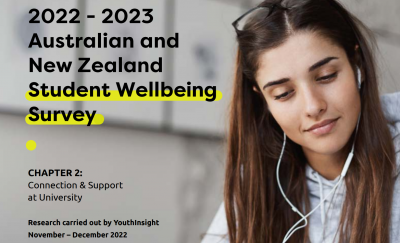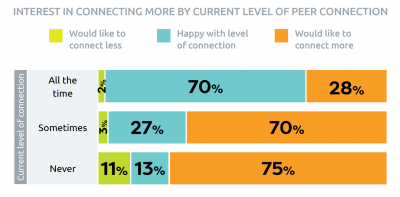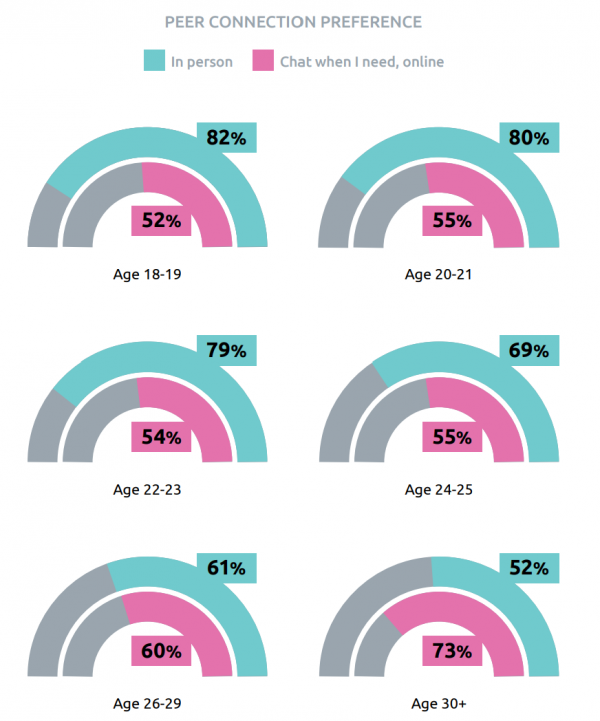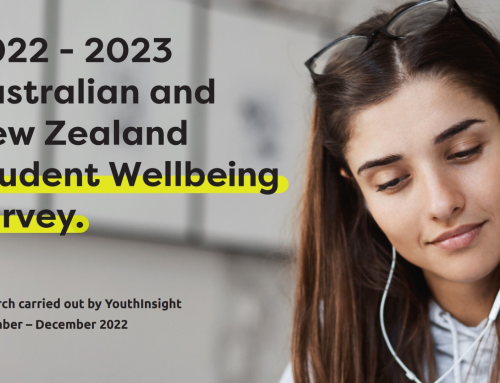As university students navigate their academic journeys, many are searching for a greater sense of community. YouthInsight asked University students from Australia and New Zealand about their connection and support at University as part of Studiosity’s annual Student Wellbeing Survey.
Here is a round-up of the key insights from Chapter 2: Connection & Support at University (2022 – 2023 Australian and New Zealand Student Wellbeing Survey).

KEY INSIGHTS
- Students are calling for more opportunities for peer support and connection, with 14 per cent of students reporting feeling completely disconnected at University
- Students aged 18 to 25 prefer to connect with peers in-person, while students aged 30+ favour online connection
- Lack of awareness is one of the main reasons students don’t take part in peer support programs, with 1 in 3 students who are not currently taking part wanting to be involved
In our recent research with over 1,000 Australian and New Zealand university students, we found that a sense of community was related to stress. Students with a strong sense of community were slightly less likely to experience weekly or more frequent stress (69%) than those who did not have this community sense (77%).
So, what would make students feel a greater sense of community at University? Many students suggested on-campus events and activities, or encouraging students to visit campus more often. Access to social groups, clubs, and societies was also frequently mentioned. Additionally, some students expressed a desire for greater peer and study support.
Opportunities to grow feelings of peer connection and peer support
Though only 15 per cent of students reported feeling heavily connected to their peers, the majority did feel some level of connection. Importantly, 14 per cent of students surveyed reported feeling completely disconnected, with 30+ year old students reporting lowest levels of connection. Overall, most students expressed a desire for greater connection, with two out of three indicating that they would like to connect more with others. This desire was strongest among 18–23-year-olds.
Our research shows that students who would like greater peer connection are stressed more often. Universities can proactively address some issues of stress by implementing robust initiatives that encourage and provide the connection students are calling for.

Online or in-person connection?
When it comes to the way students prefer to connect with others, younger students (18 – 25) have a stronger preference for in-person connection, while older students prefer online (possibly reflecting their need for greater flexibility as they fit study around other commitments). Full-time students, on-campus students, those in metro areas, and parents or carers were also more likely to prefer in-person connection.
However, as connection types scored above 50% across all age groups, Universities need to take note of these preferences as they develop and implement different peer connection methods in a way that best suits their diverse student body.
1 in 3 students want to take part in peer support programs
Currently, only 30 per cent of students make use of their university’s peer support programs – with use being higher among those attending campus full-time or using mixed study modes. Here, lack of need and awareness were the main reasons for not engaging with these programs. Importantly, 19 per cent of students reported feeling too self-conscious to engage and a further 19 per cent were not sure about how to reach out. Of those students who did not take part in a peer support program, one in three would have liked to.
These results highlight that universities must:
- Better promote peer support programs broadly;
- Make such programs accessible;
- Develop messages to normalise access to these services; and
- Highlight the benefits of taking part.
KEY TAKEAWAYS
As students are calling for a greater sense of community and peer support during their studies, Universities must consider the preferences and needs of their diverse student body:
- Universities need to implement greater opportunities for connection for those groups of students currently overrepresented as not connecting with others. This includes students 30 and over, part-time students, online only students, and students in regional and rural areas.
- Universities should take note of student preferences about how they want to connect with their peers, and foster a range of different connection methods to increase the opportunity for students to connect in a way that best suits them.
- By offering a range of connection methods and engaging in better promotion of peer support programs, universities can help students navigate the challenges of their academic journeys and build meaningful relationships along the way.

Q. How would you prefer to connect with another student?**
*The survey ran from 14th November to 6th December 2022 and gained a total of 1,137 responses, of which 995 were in Australia, while 142 were in New Zealand. All Australian public universities were represented in the Australian sample. In New Zealand, all universities were represented.
**Data charts sourced from Chapter 2: ‘Connection & Support at University’ report.









Leave A Comment